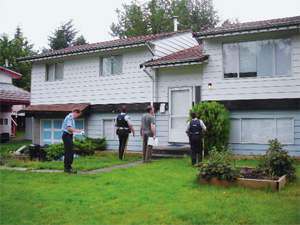
Equipment
Cracking down: Software helps communities locate grow ops and reduces threat to public safety
It was a classic case of: “Be careful what you wish for.” In 2006, the City of Surrey in B. C. successfully lobbied the provincial government to provide legislation giving cities access to hydro consumption data to help them identify potential marijuana grow operations.
March 18, 2008
By Karin Mark
It was a classic case of: “Be careful what you wish for.” In 2006, the City of Surrey in B. C. successfully lobbied the provincial government to provide legislation giving cities access to hydro consumption data to help them identify potential marijuana grow operations.
 |
| Hydro consumption data has helped police and firefighters identify and target potential marijuana grow operations. PHOTOS COURTESY SURREY FIRE SERVICES |
The result was huge volumes of data that threatened to overwhelm Surrey’s Electrical and Fire Safety Inspection (EFSI) initiative, an innovative public-safety program that targets residential grow operations. However, the development of new software to process the data has made the EFSI program more effective – and more adoptable by other communities.
“The high volume of the data made us realize we needed a more three-dimensional way of tracking what we were doing, instead of one dimensional, like a spreadsheet,” Surrey Fire Chief Len Garis explained. “Because the software processes the data on so many levels, it makes us instantly intelligent about what’s going on out there.”
Surrey implemented its first EFSI team in 2005 and doubled its size in early 2007. The program uses the city’s powers to conduct electrical and fire safety inspections as an opportunity to reduce the safety hazards associated with indoor grow operations – primarily fire and electrocution – but also health risks, structural issues and crime. It’s an administrative approach that helps address large numbers of low-level grow operations while freeing up police to target the larger crime organizations.
Prior to the new legislation, the team worked from RCMP tips on addresses that were later verified by BC Hydro as having unusually high electricity consumption. Data was manually entered into a series of spreadsheets.
After new provincial legislation was adopted in May 2006, BC Hydro started sending Surrey large batches of addresses with high-consumption data after each two-month billing cycle. The first batch had 1,600 addresses. The next had 1,300. Now, it’s the EFSI team’s job to sift through the files and then run them by the RCMP to ensure the inspections won’t conflict with an existing police investigation, or that the site doesn’t pose a personal safety threat to the inspectors.
What would have been time-consuming and tedious to do manually is a simple process using the new Electrical & Fire Safety Inspection Application developed by B.C.’s Data Accent.
The software analyzes the electricity consumption data, flagging addresses based on the team’s criteria. It has also automated a variety of EFSI data-collection processes, such as the recording of observations and information from property visits, as well as research and correspondence. The inspectors’ data can be entered into laptops in the field and synchronized with the master database at the end of each day.
| How to spot a grow op
• Suspects do not appear to regularly attend jobs but drive expensive
|
“It takes the data that, if it was in the raw material format, would be difficult to disseminate and make decisions from,” said Surrey Fire Service Capt. Cal McKibbon, the EFSI team co-ordinator. “Without a doubt, it’s made the process faster and easier. Without it, we’d be working from a big data sheet spread out across the table.”
In anticipation of the onslaught of electricity consumption data, Chief Garis approached Data Accent’s Suzanne Landry in the spring of 2006. In the months that followed, Landry worked closely with the team to develop a custom application reflecting its requirements for data input, storage, analysis and reporting.
“We were looking for an integrated system that would populate multiple fields and remove the multi-step process we had before,” said Carol Richardson, a City of Surrey clerk who provides administrative support for the EFSI team. “It’s certainly allowed us to deal with a higher volume. We really have a fine handle now on where we are with our stats, and we’ve been able to fine-tune other administrative areas and look further into our stats to apply the information.”
For example, the team can now easily target potential repeat offenders. In an estimated 10 per cent of the cases, properties made safe through the EFSI process later revert to grow operations. Now, the ability to easily compare new electricity consumption data to existing files means repeat addresses are instantly flagged and a team can be dispatched in a timely manner.
The software has also standardized how data is collected for individual addresses, making it easier to compare and analyze. Instead of entering information into spreadsheets in varying formats, inspectors now complete a series of standard fields – such as a list of check boxes reflecting more than 80 potential indicators for a grow operation, such as condensation on windows, an untidy exterior, sporadic occupation, odours and guard-dog signs. Like other aspects of the software, the indicators were developed with team input and are easily amended.
After the master database is updated with the field data, everyone on the team has access to the spectrum of information available on a particular address, including its history, electricity consumption records, grow operation indicators, inspector notes, city property information and RCMP file number.
 “Basically, the greatest benefit is allowing the office and the guys in the field to link together and provide each other with the information they need,” said Surrey Fire Service Deputy Chief Dan Barnscher, who oversees the EFSI team. “Before that, the paper trail was really immense. And it was really based on your organization in a file folder.”
“Basically, the greatest benefit is allowing the office and the guys in the field to link together and provide each other with the information they need,” said Surrey Fire Service Deputy Chief Dan Barnscher, who oversees the EFSI team. “Before that, the paper trail was really immense. And it was really based on your organization in a file folder.”
Barnscher also noted that the software is able to evolve as conditions change, “We’re so dynamic out in the field, and the people running the grow operations change week to week in their methods, and we have to make changes to keep pace with that,” he said. “This program changes from week to week because new problems and issues pop up. I can foresee the software being added to constantly and totally evolving over time.”
Landry, whose company specializes in helping organizations make the most of their data, said the organization and embodiment of the team’s guidelines and procedures makes the EFSI program more sustainable for Surrey and also provides a structure that can be easily duplicated by other communities.
“What we’ve really done is institutionalize the information,” she said. “Surrey has spent three years getting its team running. For other communities, the bulk of the work has been done – it’s just a matter of refining it and customizing it.”
Landry also noted that the software brings a valuable big-picture perspective to the EFSI data that was lacking in the previous spreadsheet-based format.
Chief Garis agreed. The software allows Surrey to take a step back and assess the data in a more comprehensive way, he said, helping the city to pinpoint trends and changes in the marijuana production industry. “As the industry changes or adapts – particularly in terms of some of the visible indicators – we should be able to identify very subtle changes because we’re tracking that stuff statistically.”
To Garis, the new software was a necessary next step for a program that has attracted national interest, is in various stages of adoption in a number of other communities in Greater Vancouver, and has certainly proved its worth in Surrey.
The EFSI team rendered safe 178 grow operations in 2005 and 127 in 2006 – in both years roughly matching the number of RCMP warrants for grow operations. In addition, the program has contributed to a significant drop in fires caused by grow operations. From 2003 to 2005, grow operation-related fires in Surrey had climbed to about 15 per year (6.12 per cent of all fires). But in 2006, the first full year of the EFSI program, grow operations caused nine fires (3.77 per cent of all fires) – a 40 per cent decrease from 2005.
The bottom line, Chief Garis said, is that the grow-operation problem is widespread and cities need a cost-effective way to deal with the associated public safety threats.
“What we’re trying to do is interrupt their business in the most efficient and effective way possible – and it seems to be working,” he said. “This software is a tool that you’ve pretty much got to have to manage this kind of volume and the dynamics that are in play here. It’s allowing us to look at what’s on the ground in front of us, while also looking upstream so we can change and adapt as necessary.”
Based near Vancouver, B.C., Karin Mark writes for publications and corporate clients and offers a range of contract communications services. She previously worked as a newspaper reporter for 13 years, earning multiple provincial and federal awards for her news and feature writing.
Print this page
Advertisement
- Answering the call: Training for industrial response
- Incident Report: Fire too advanced for interior attack